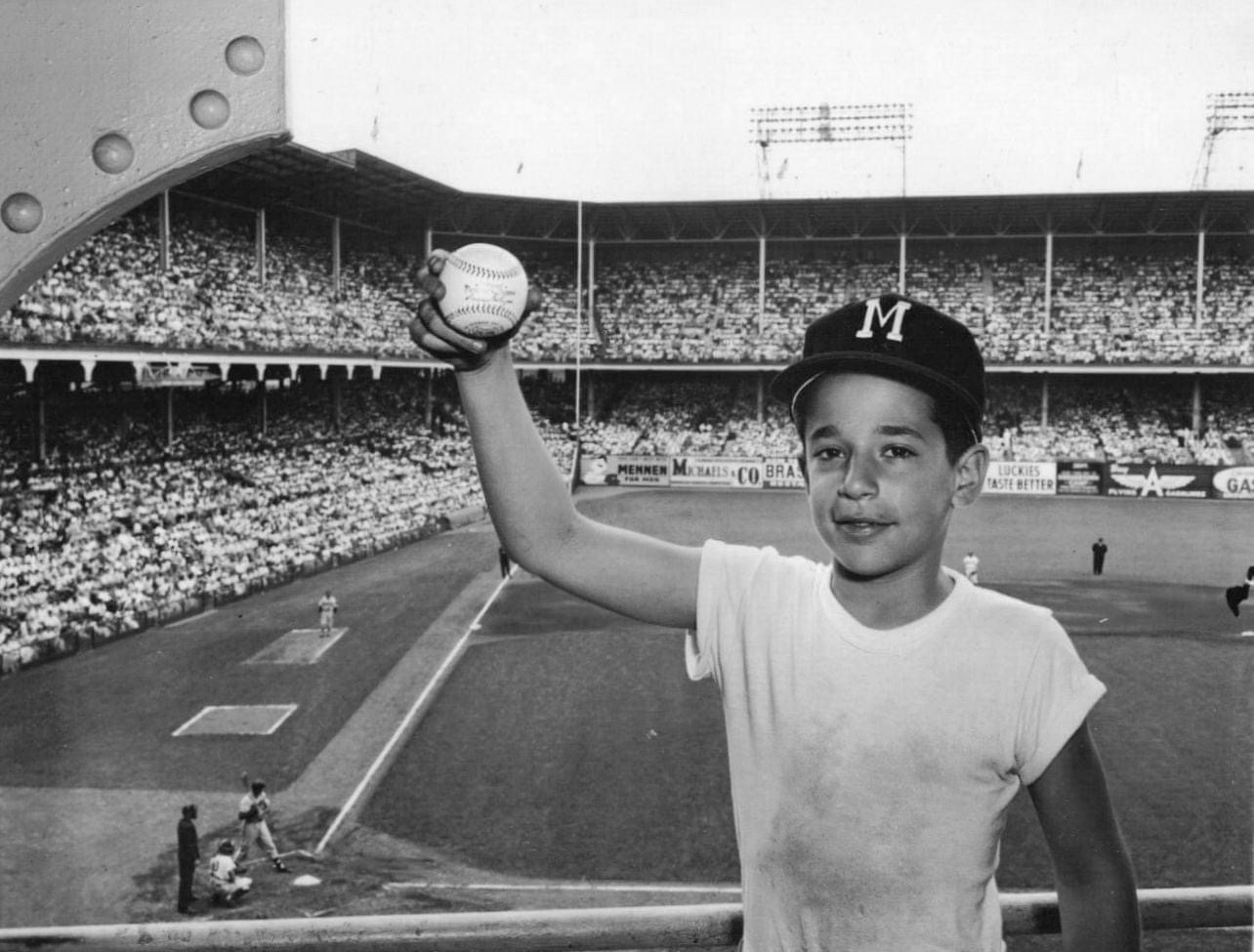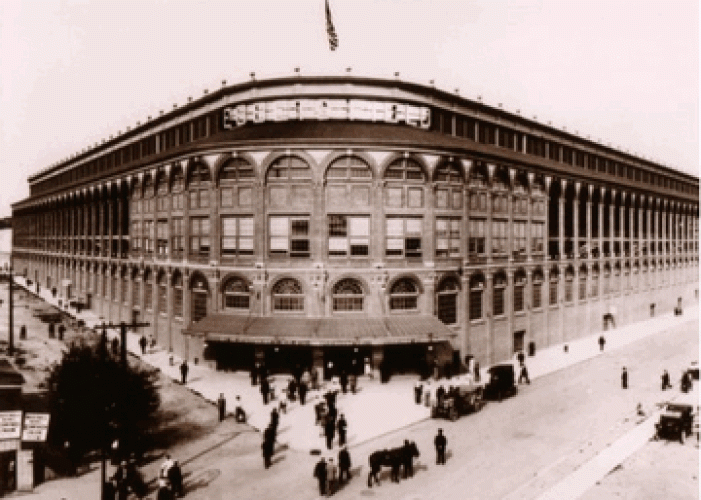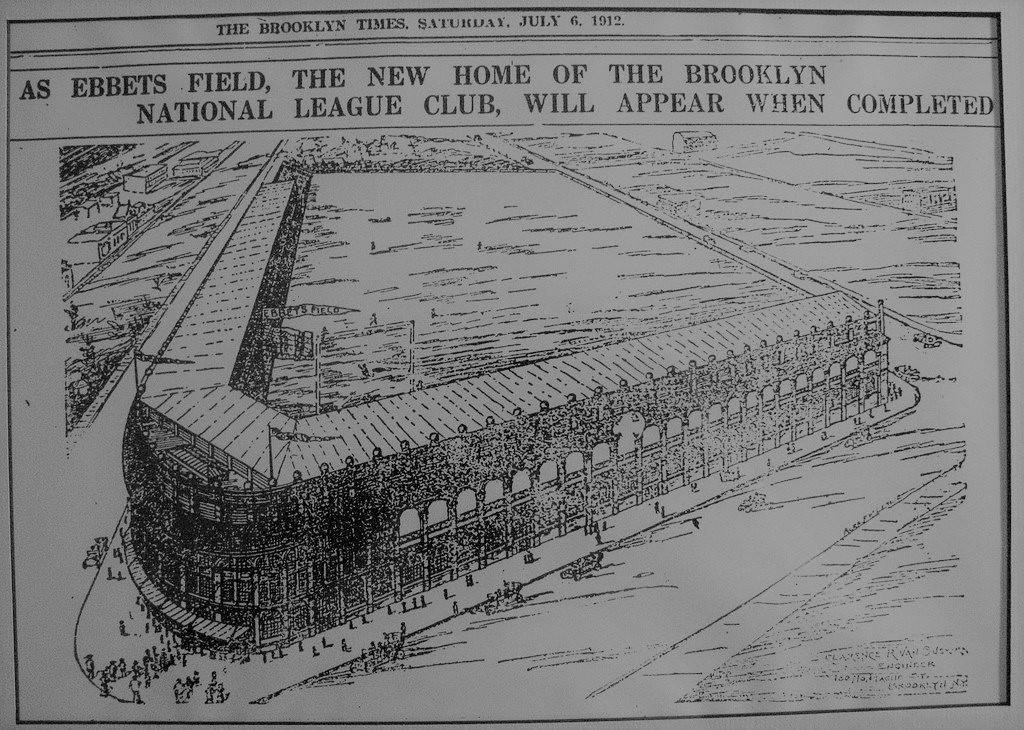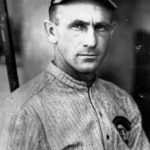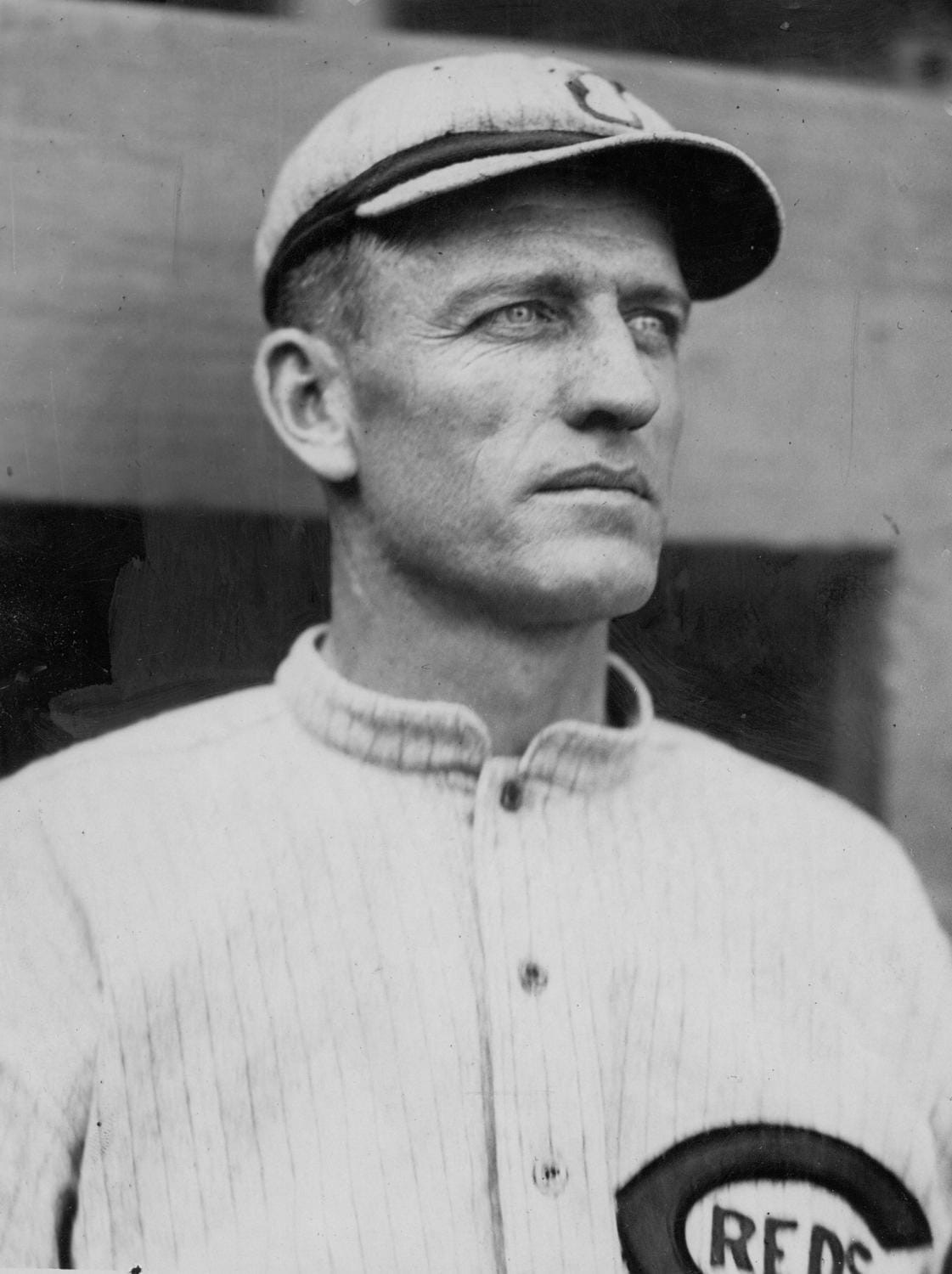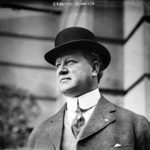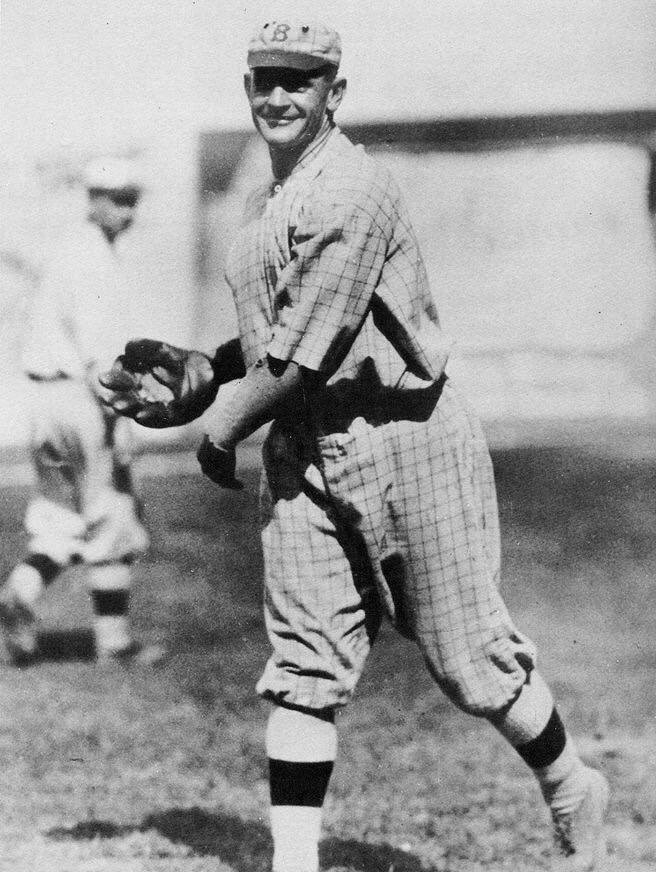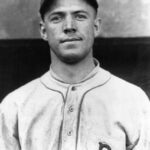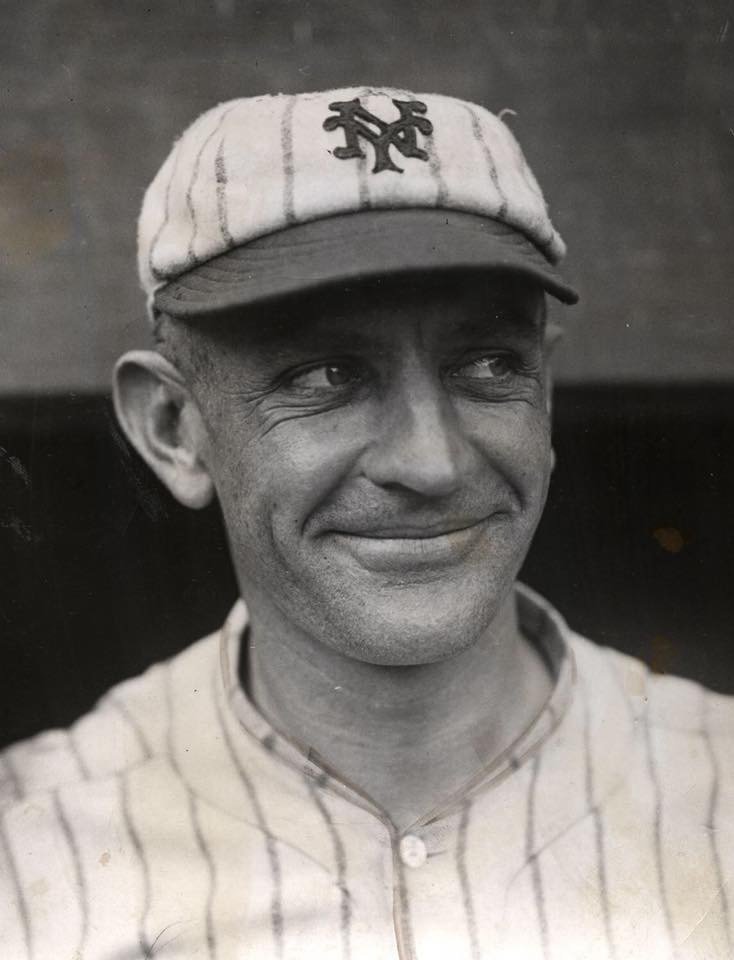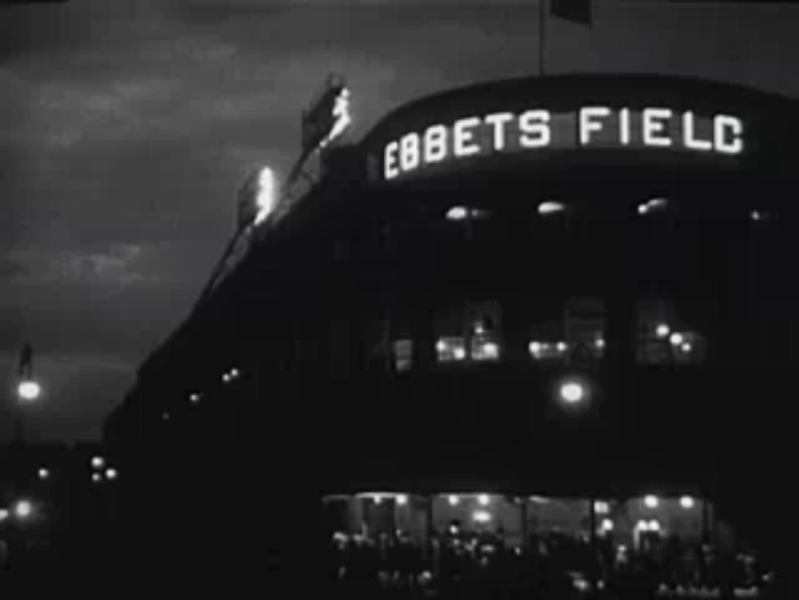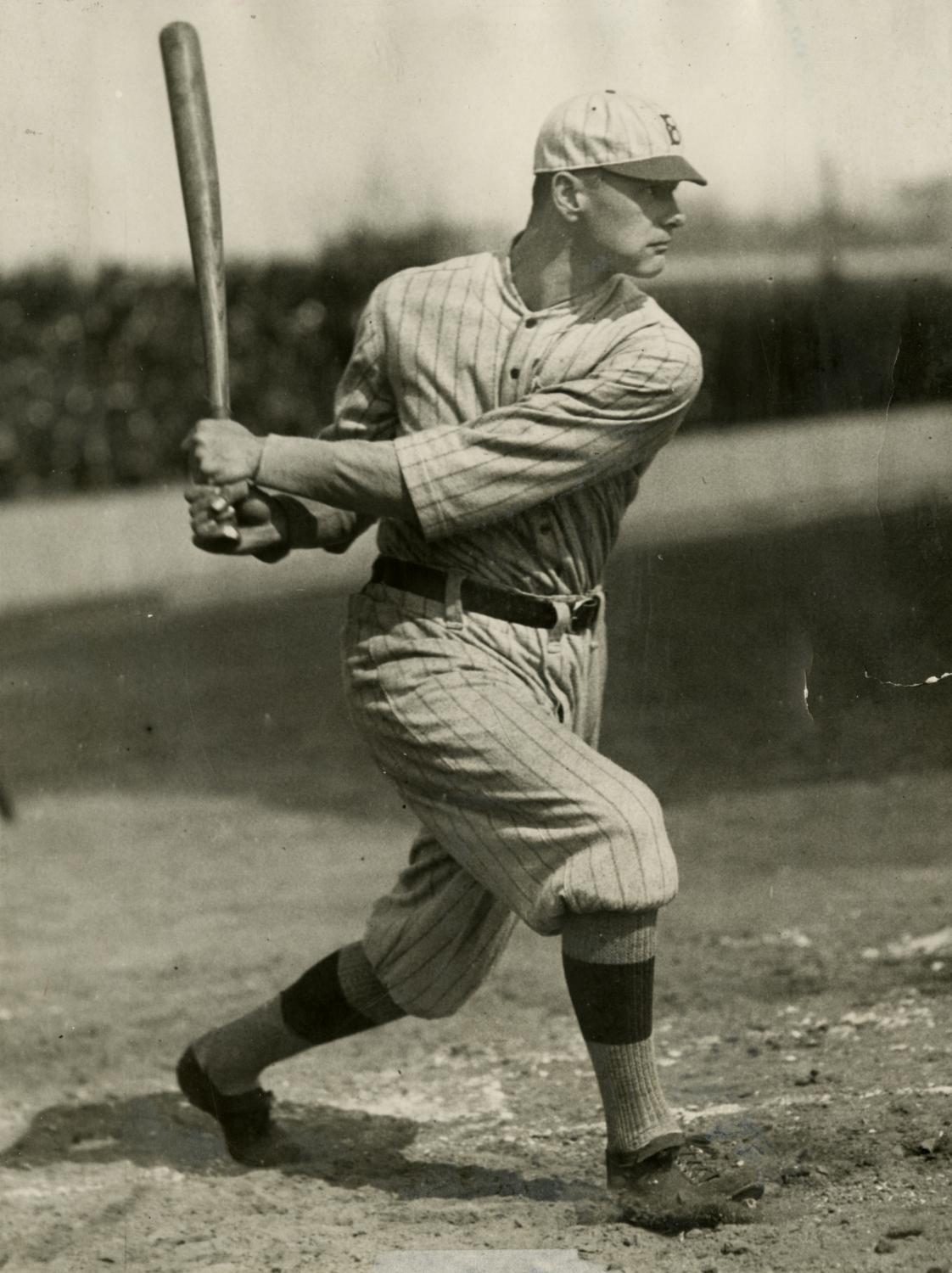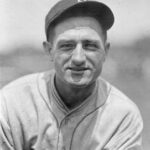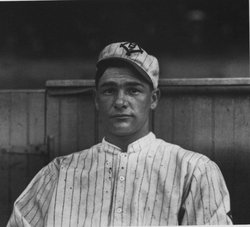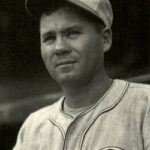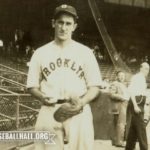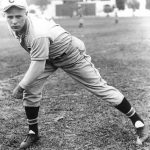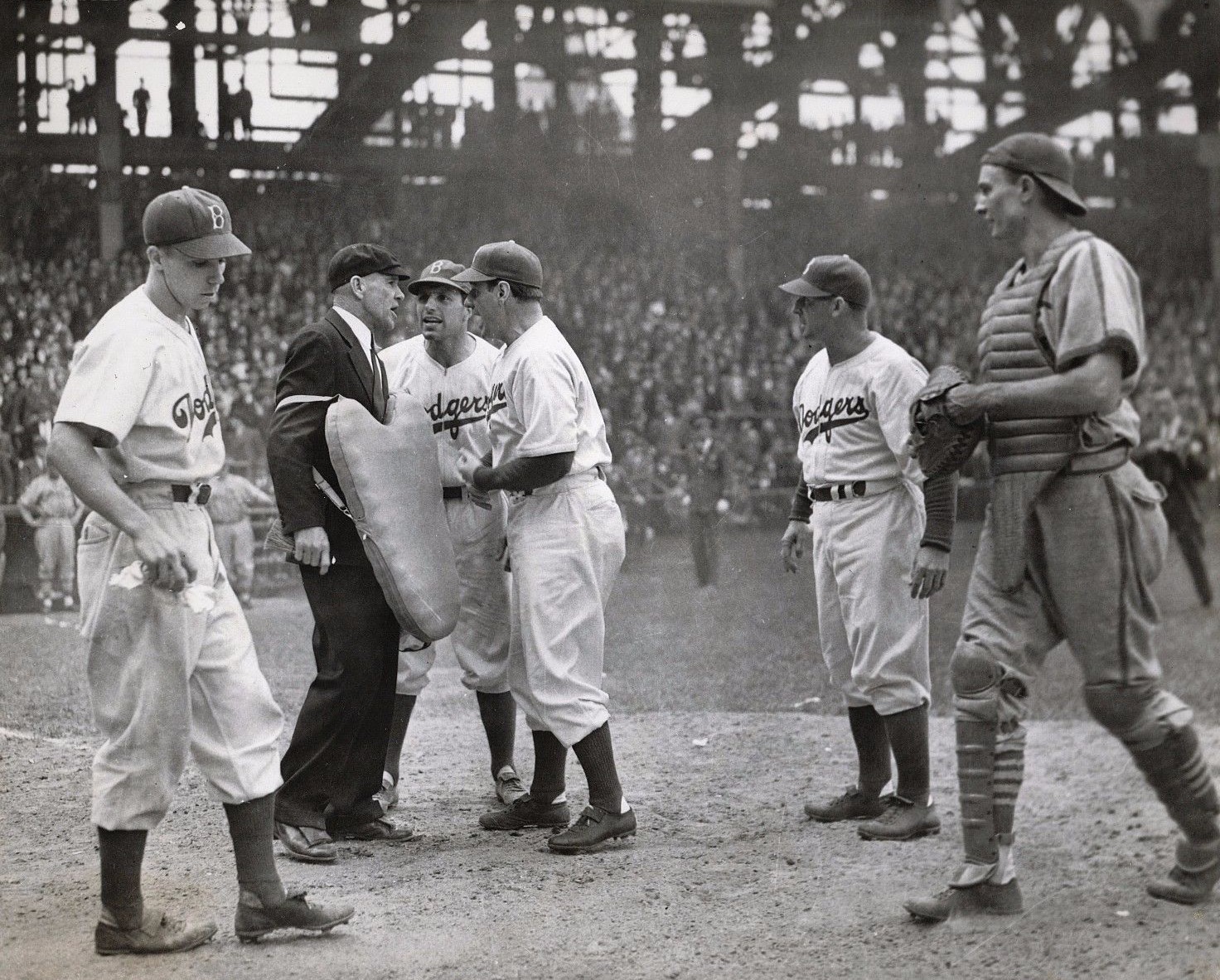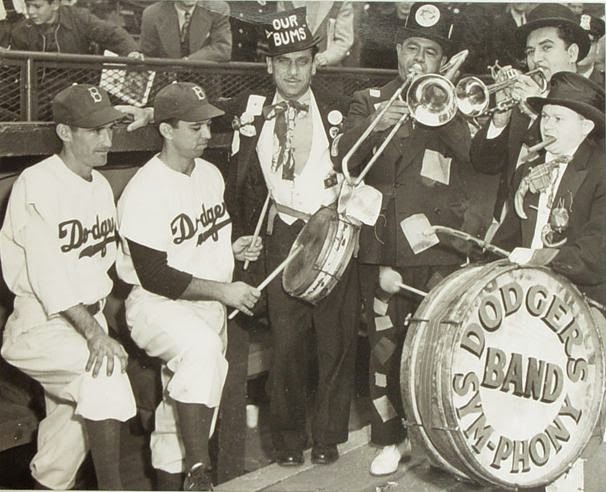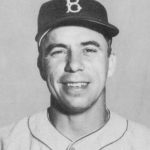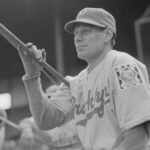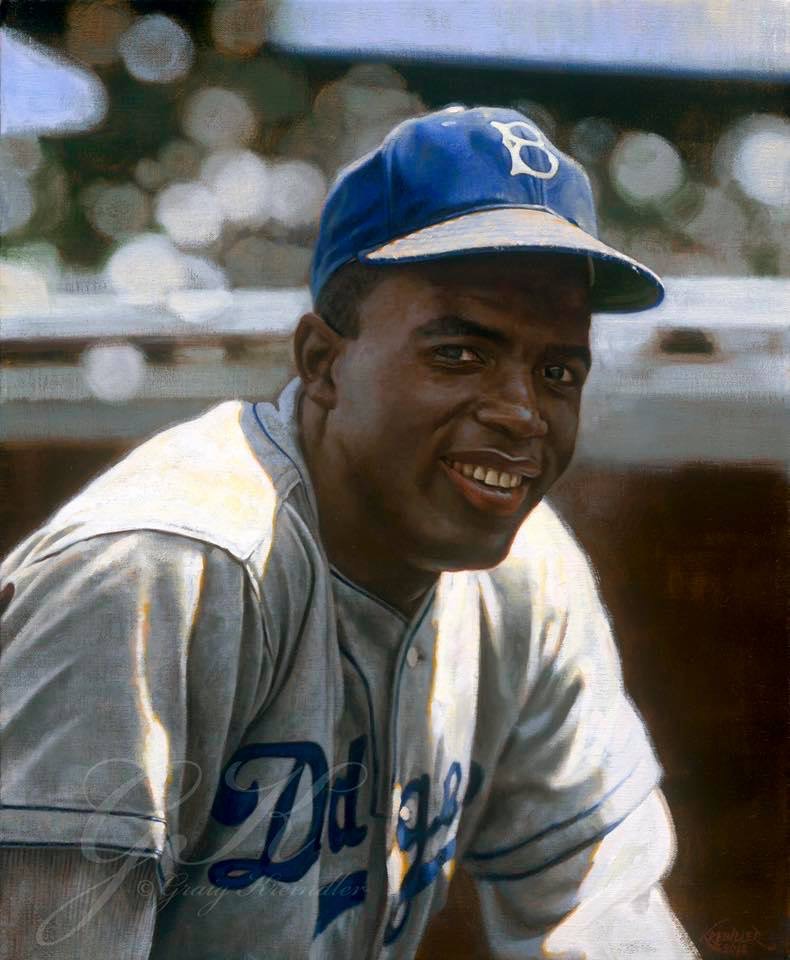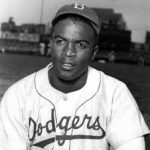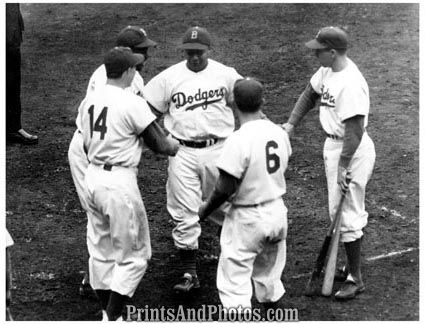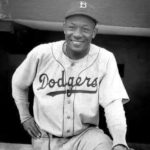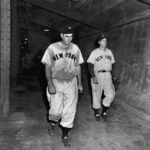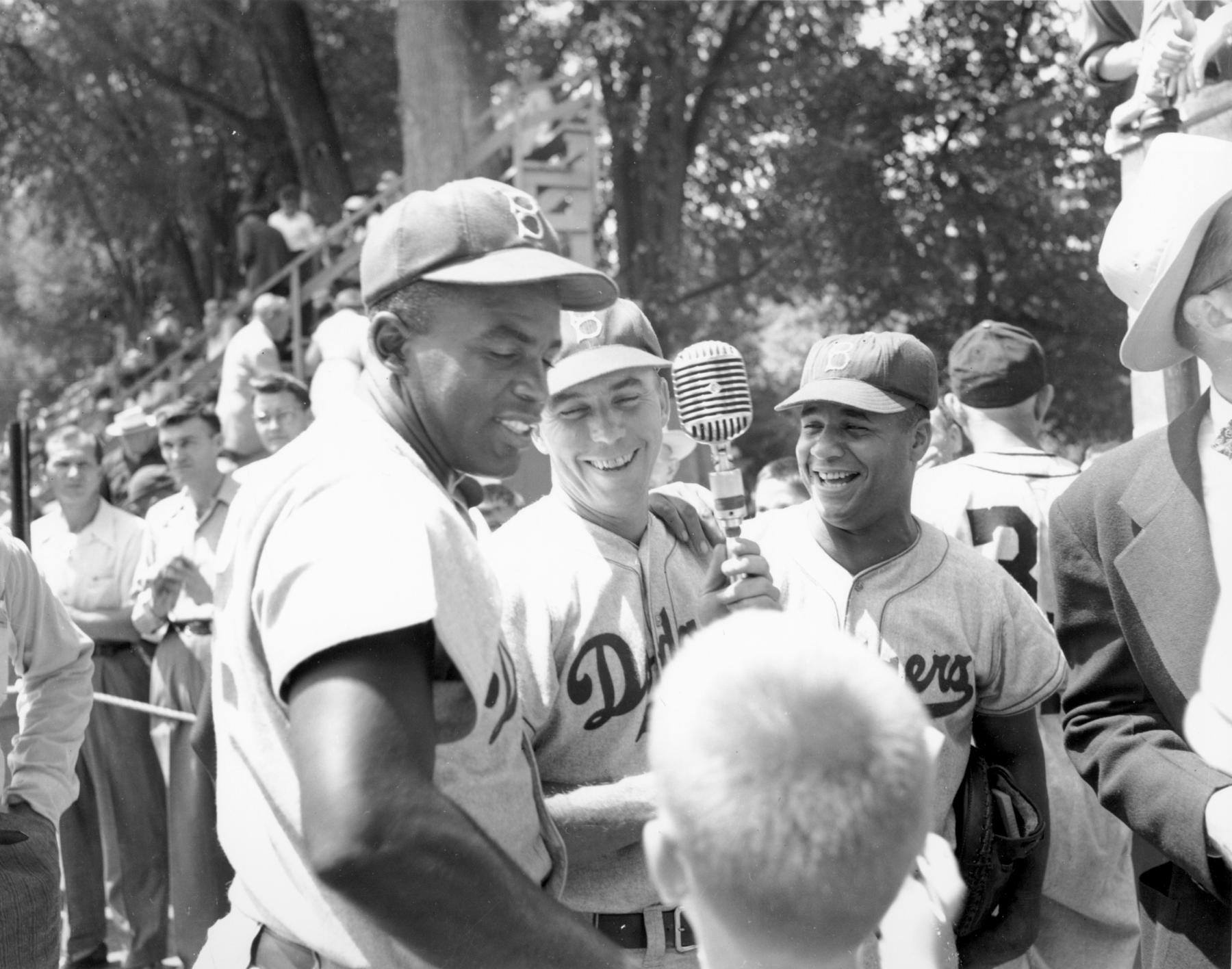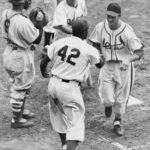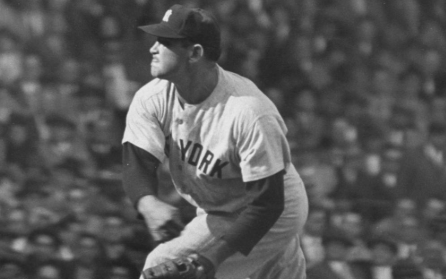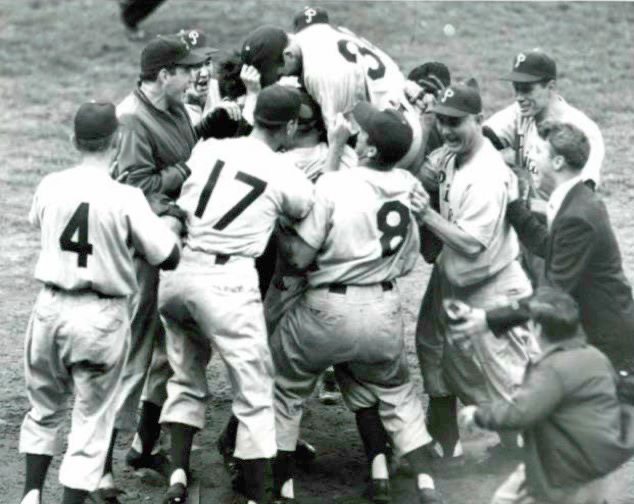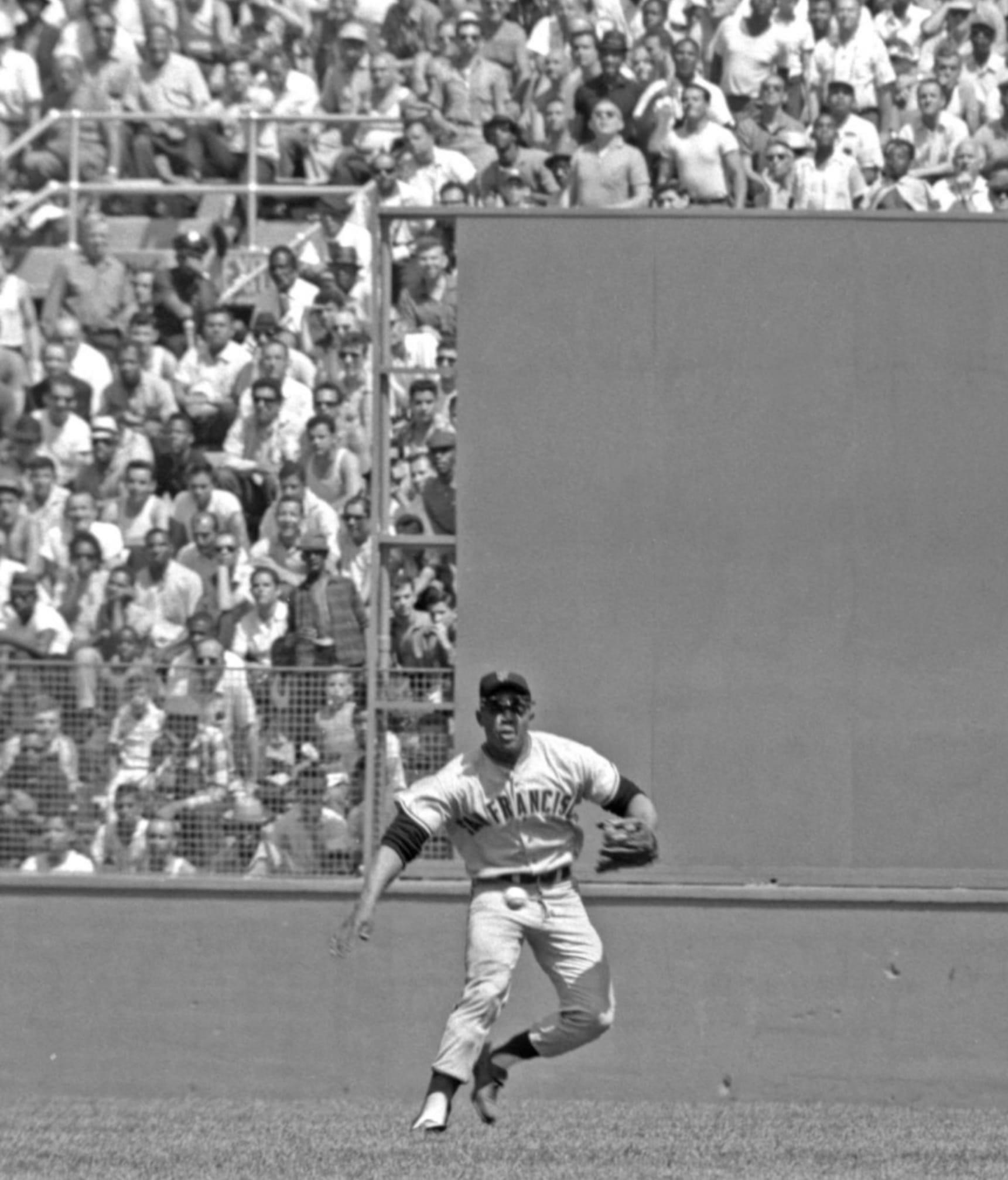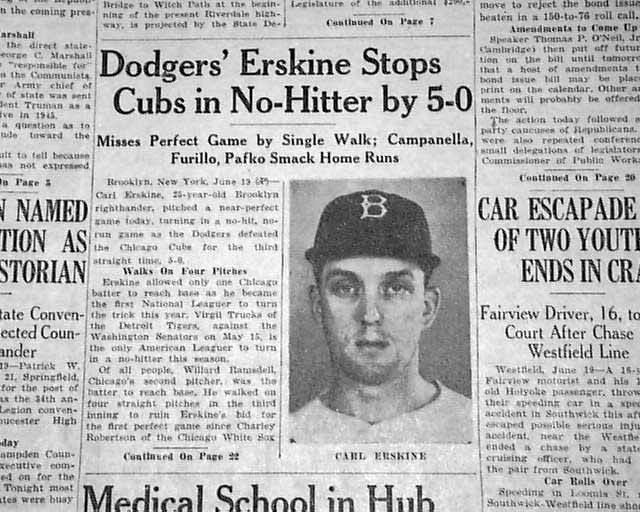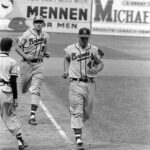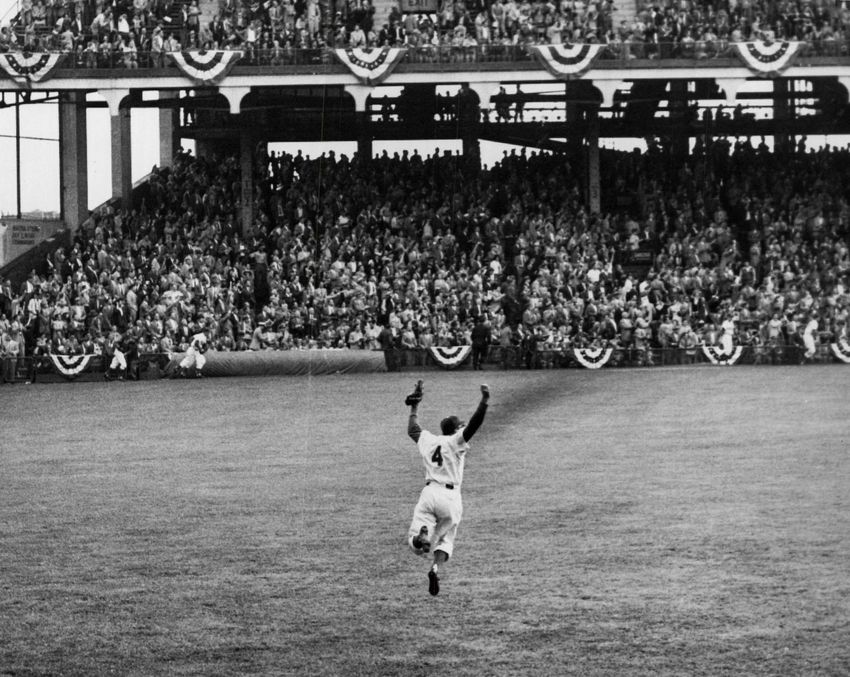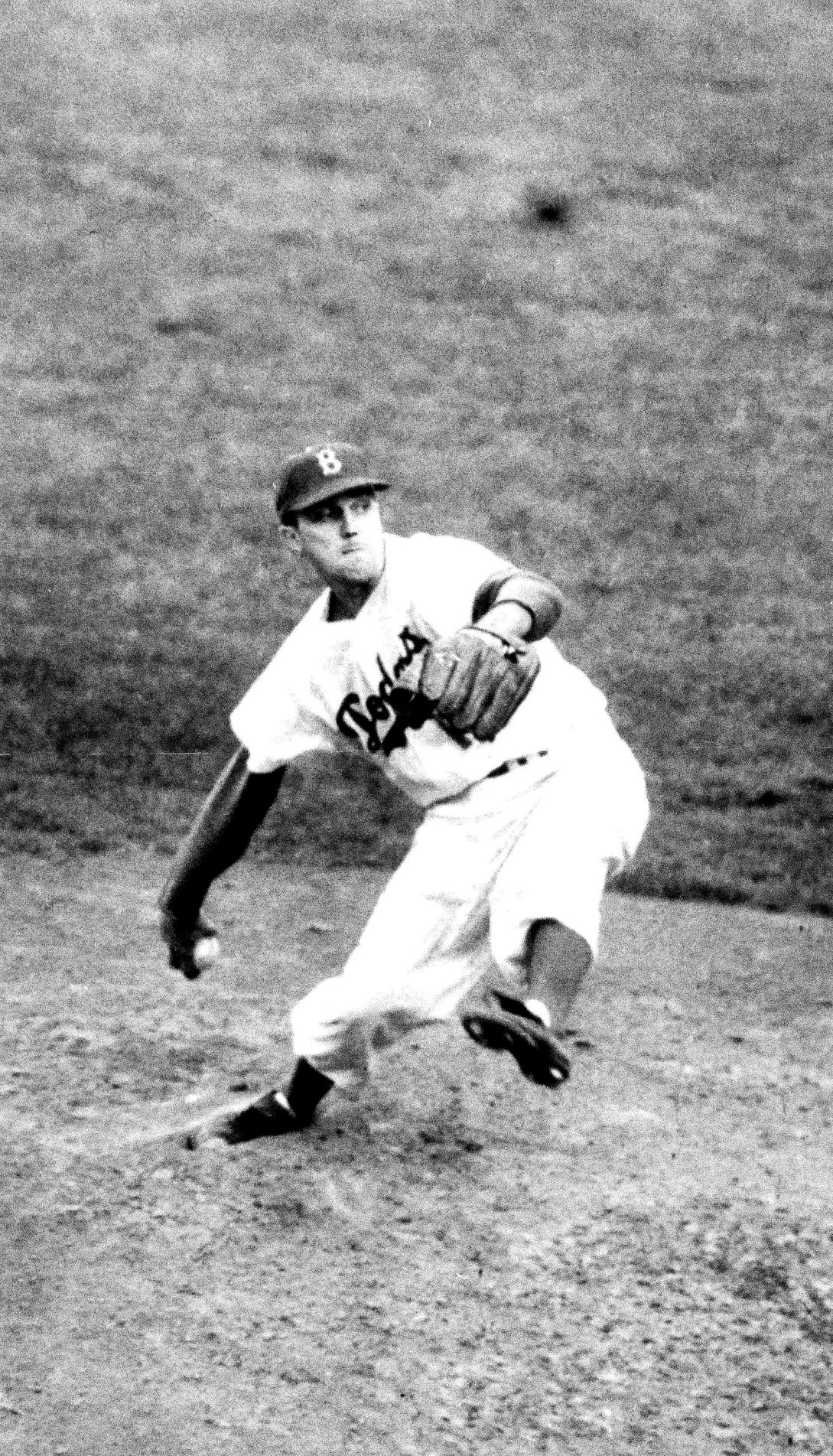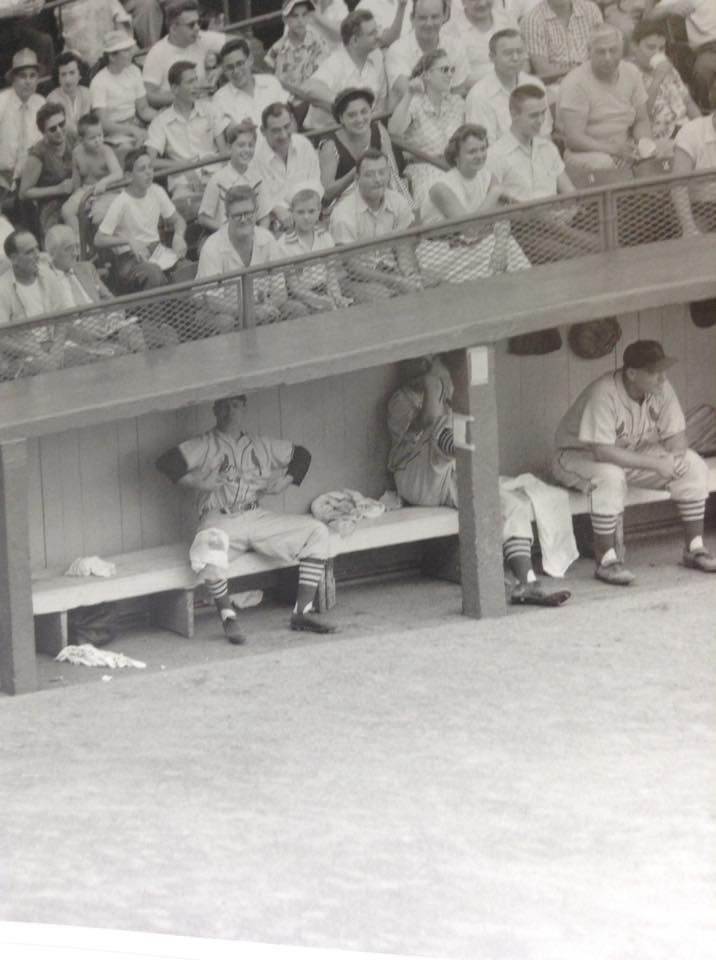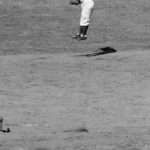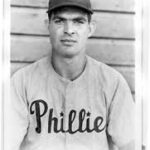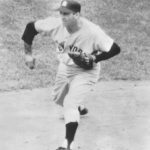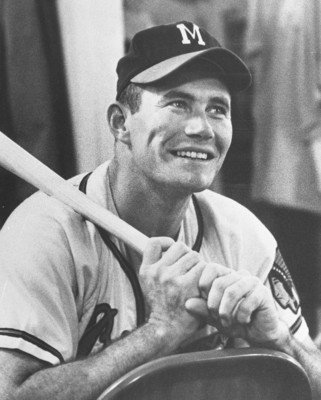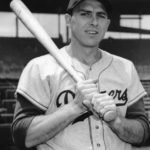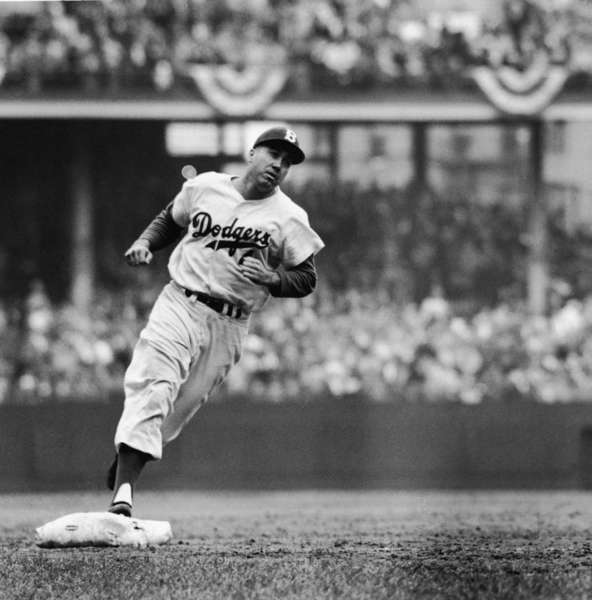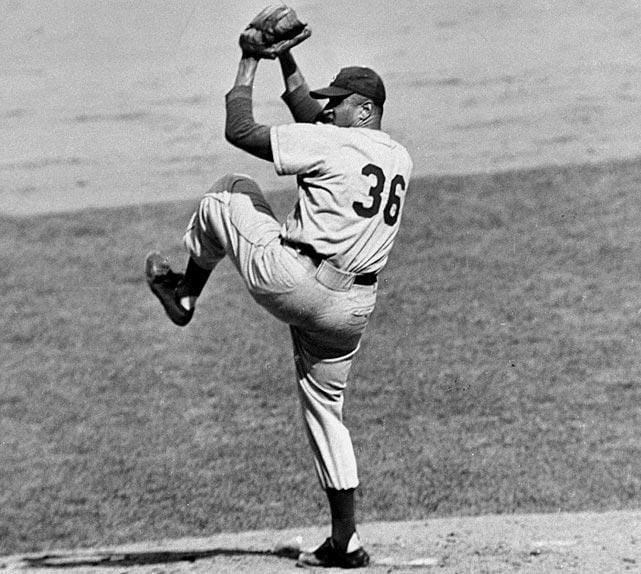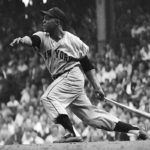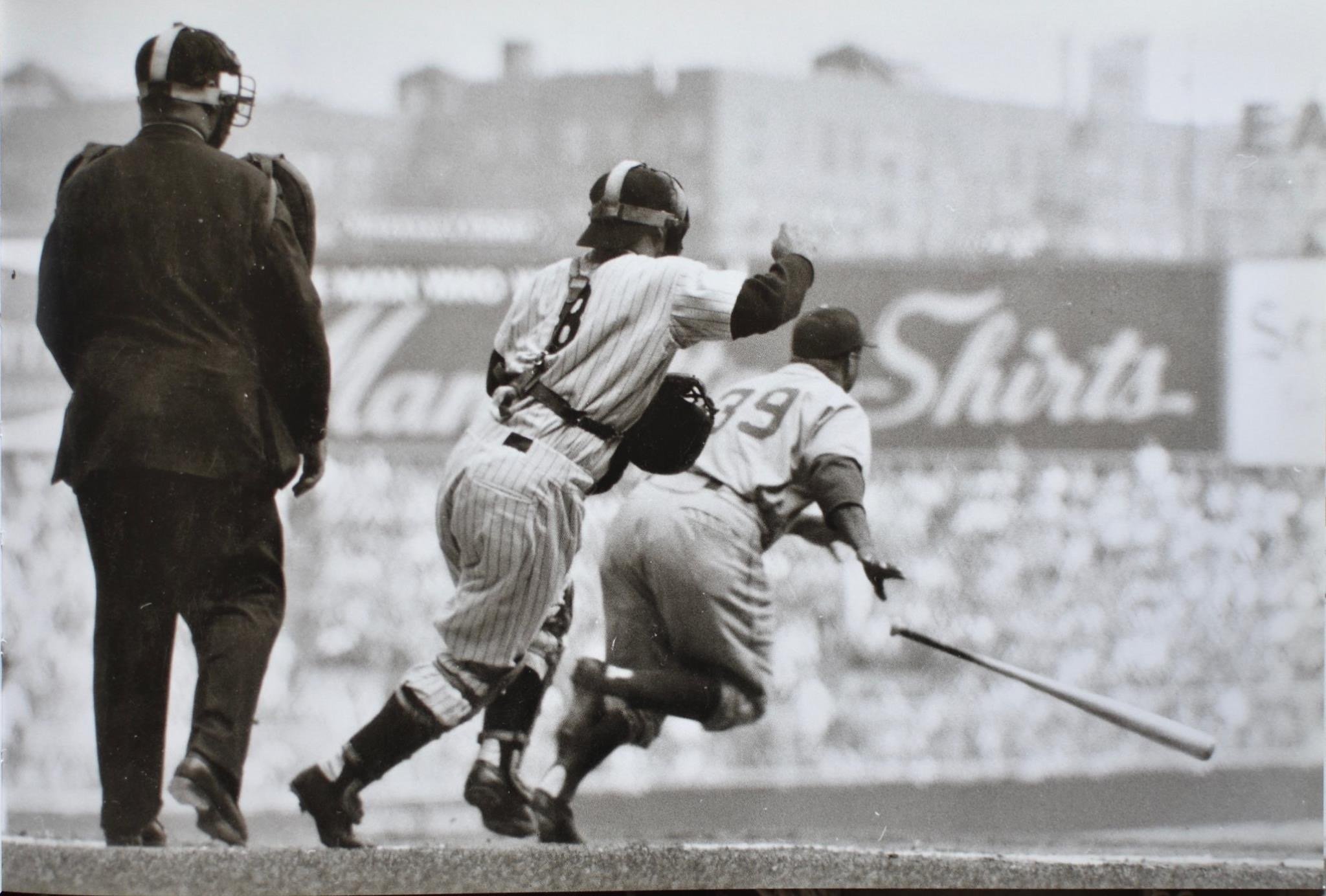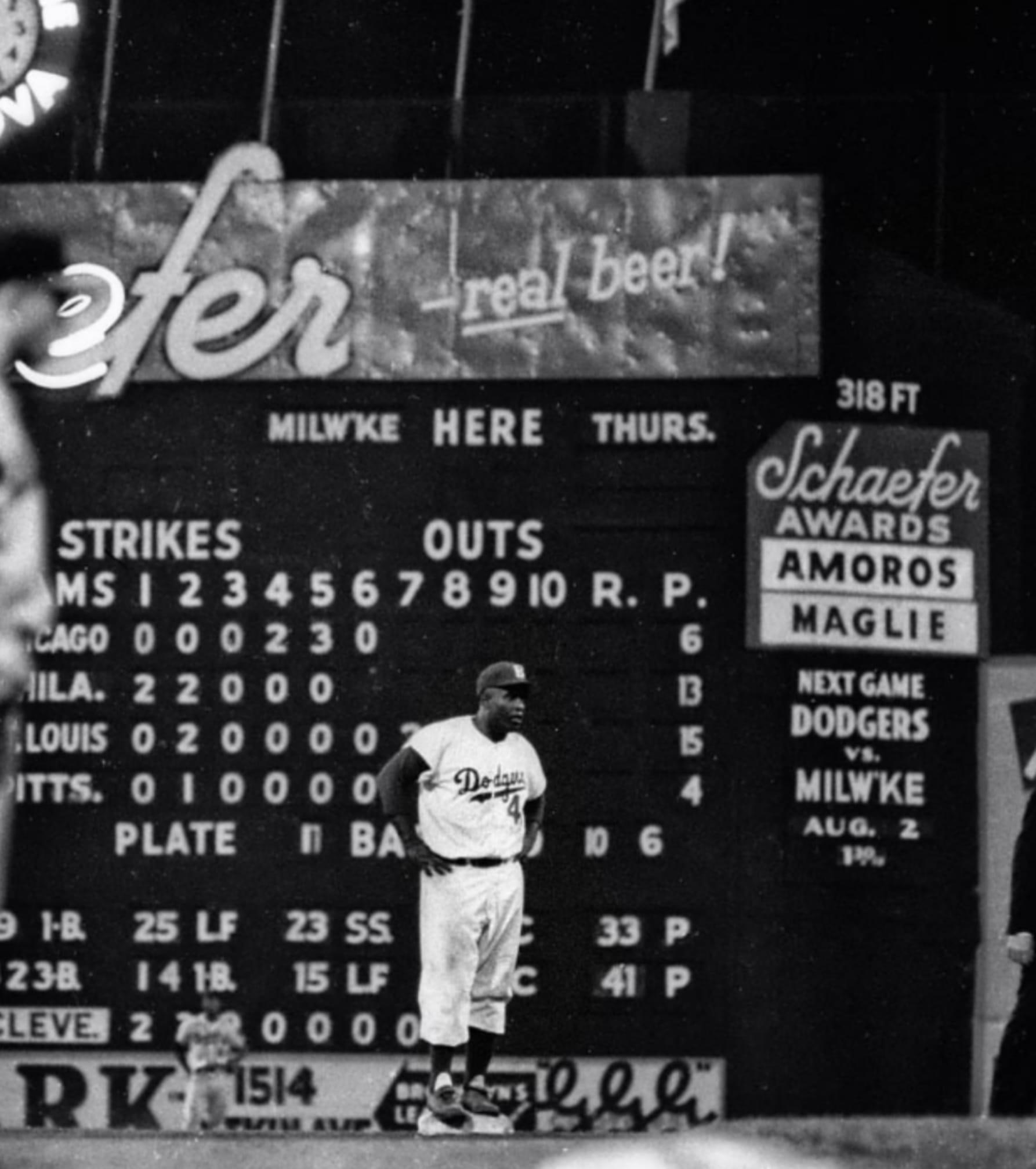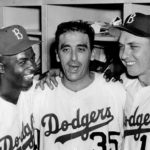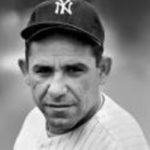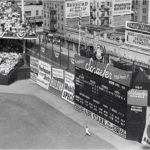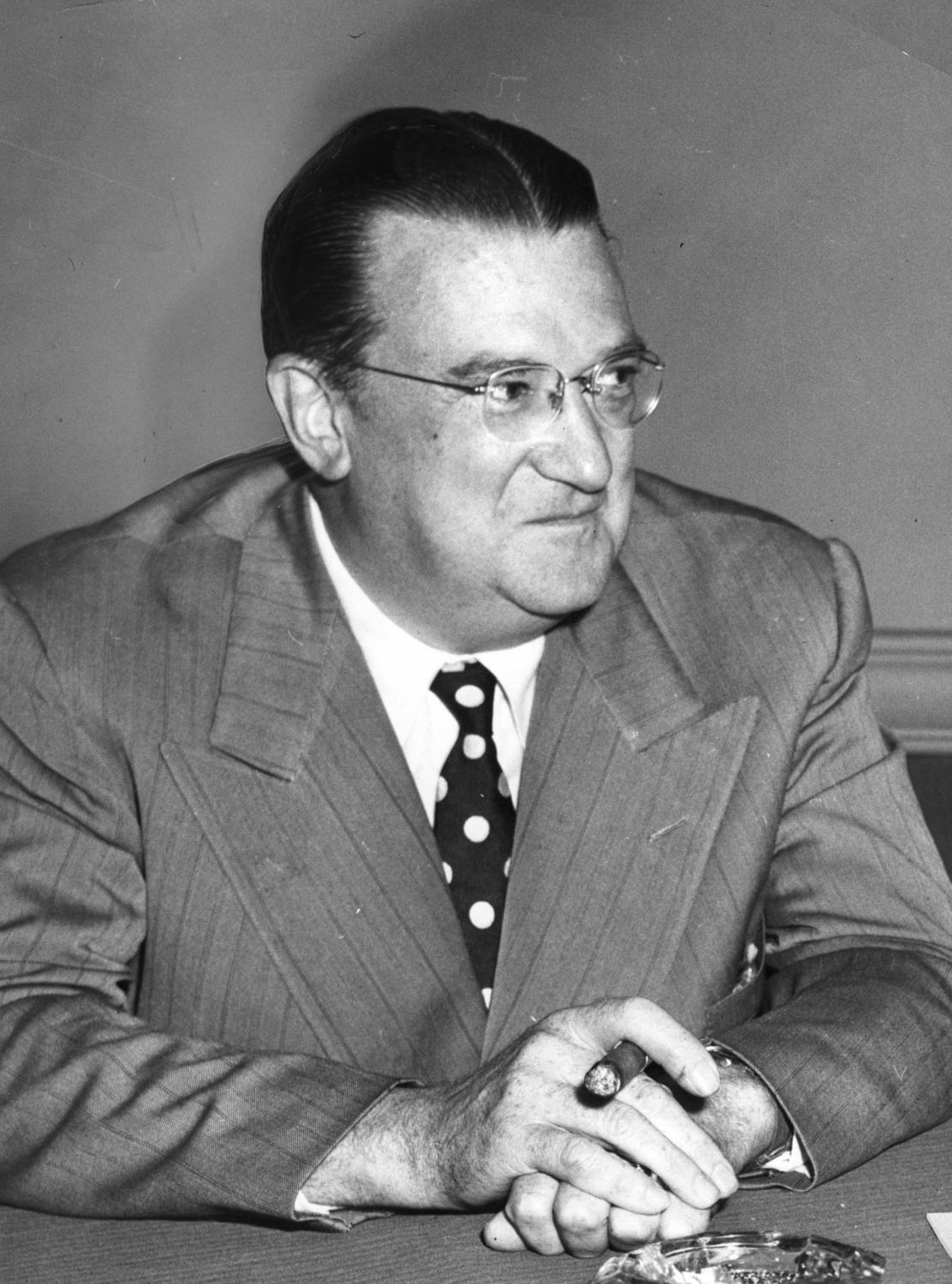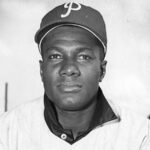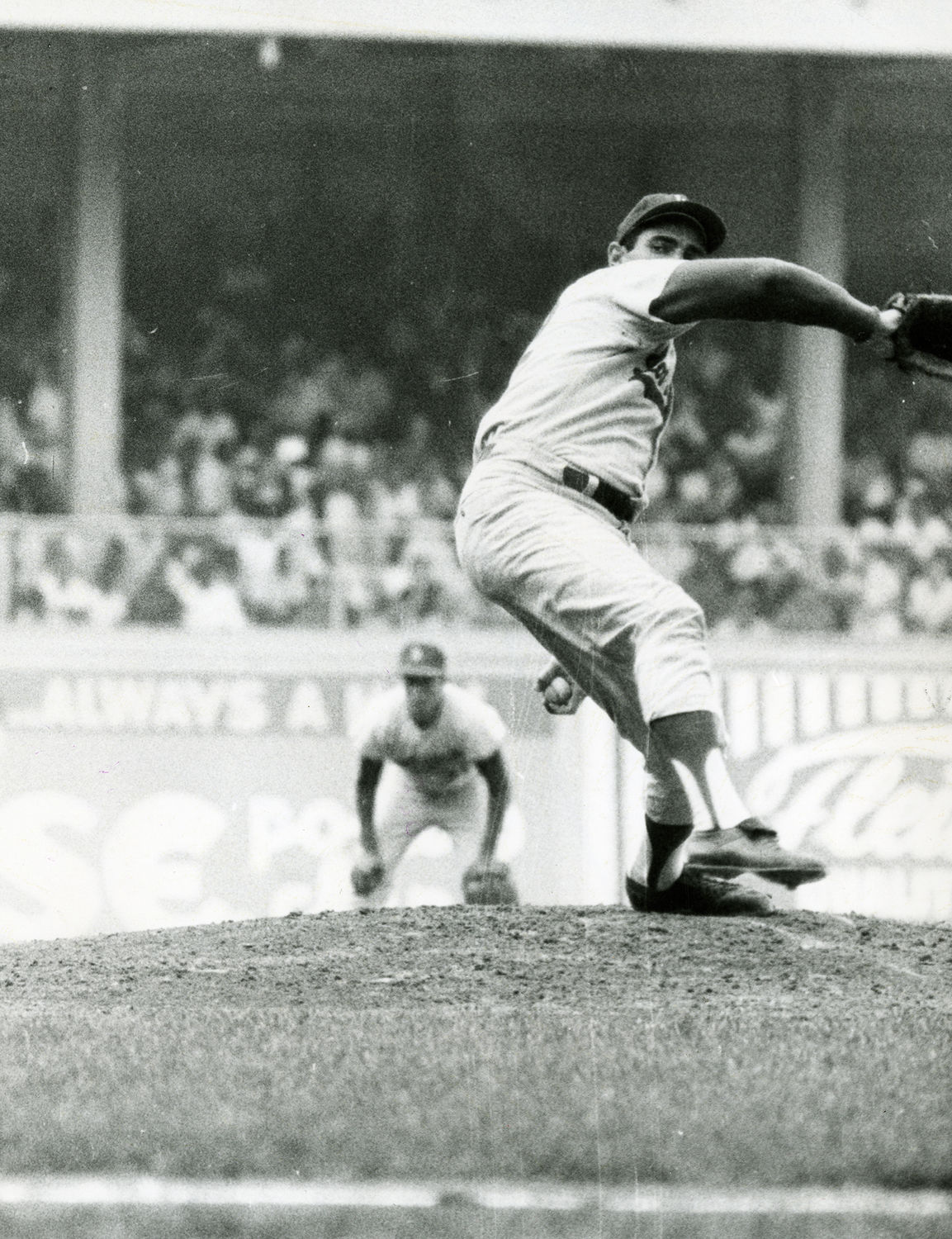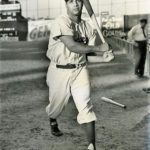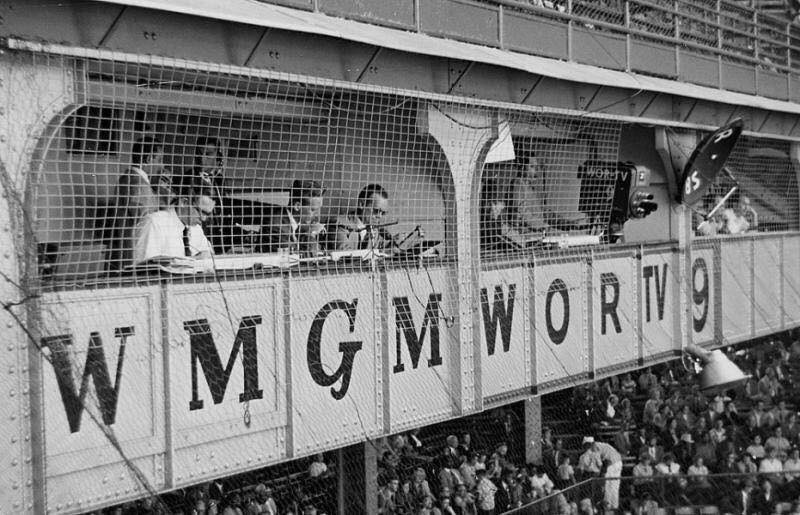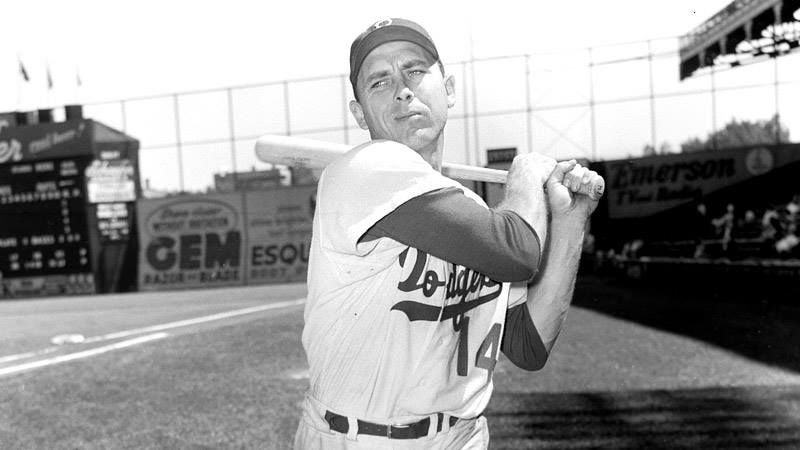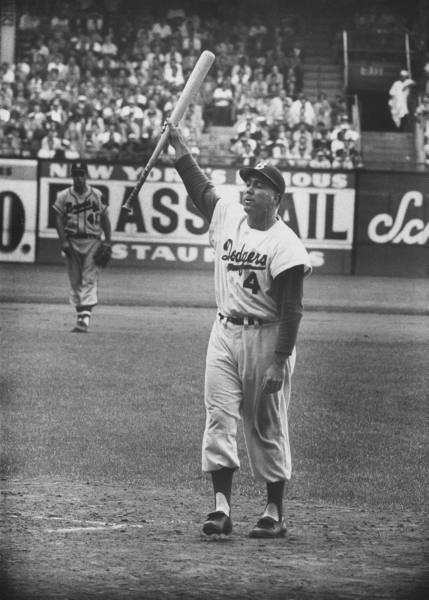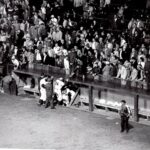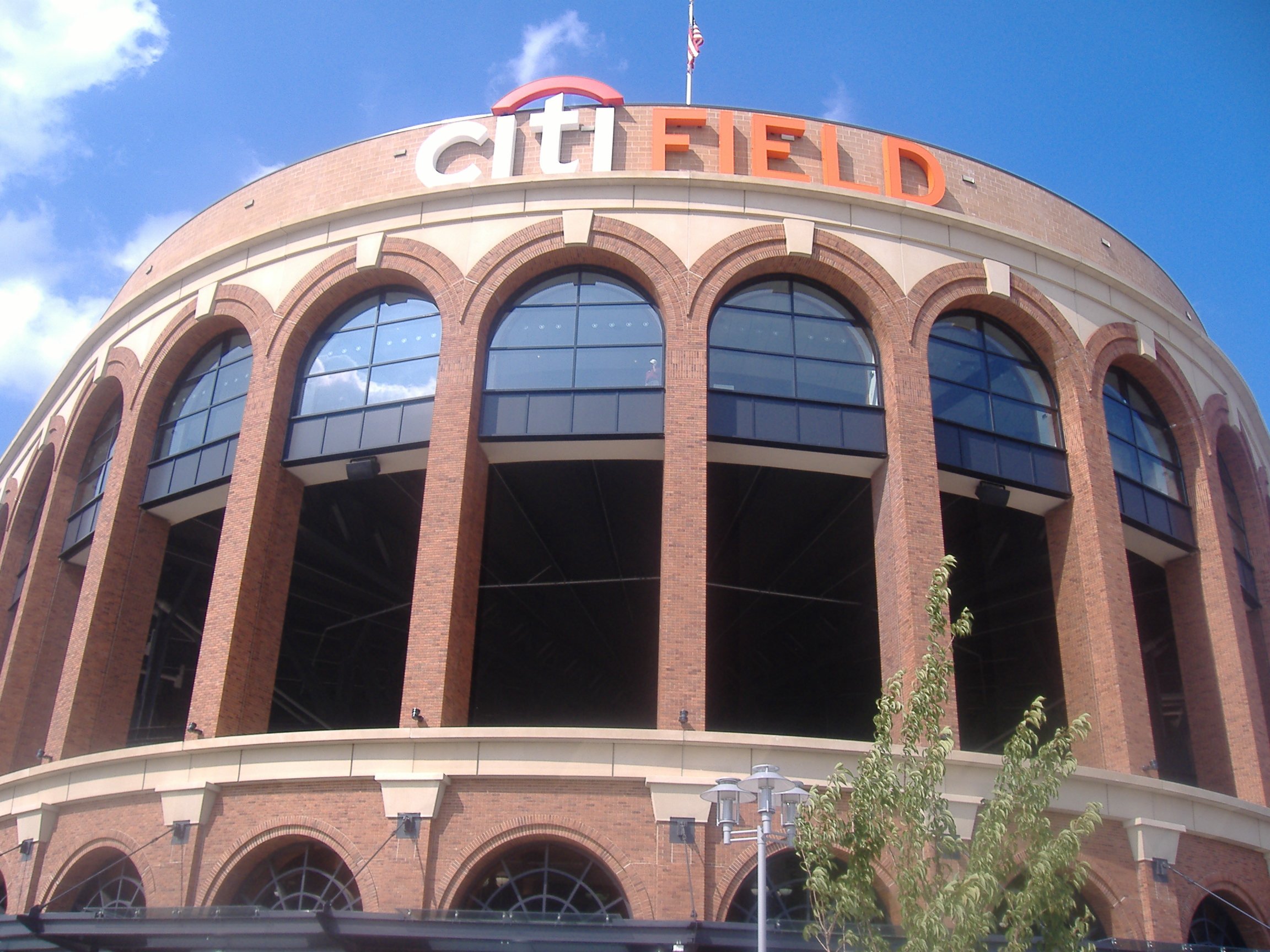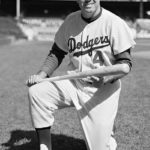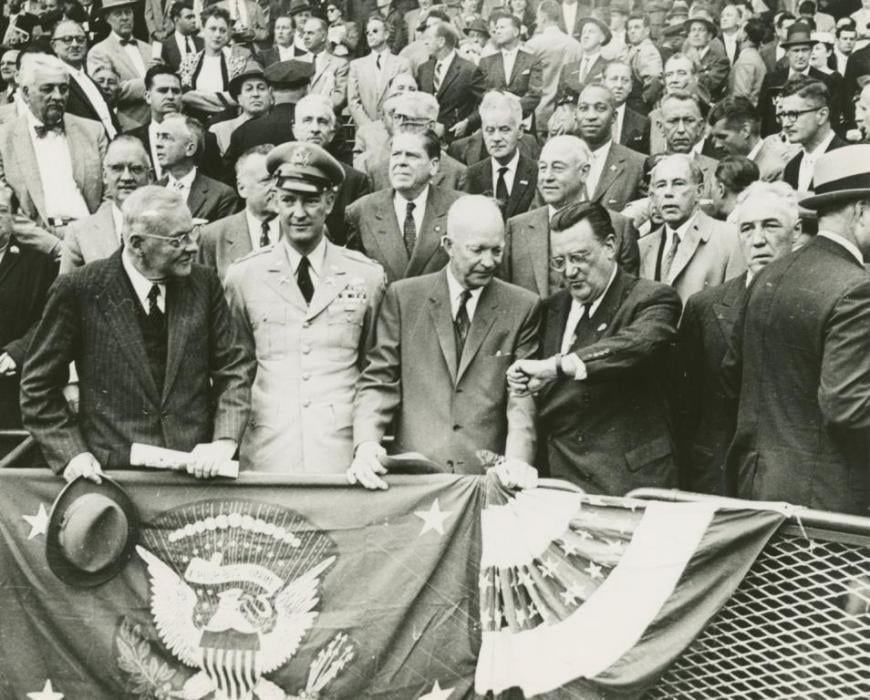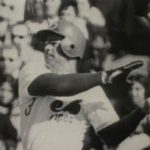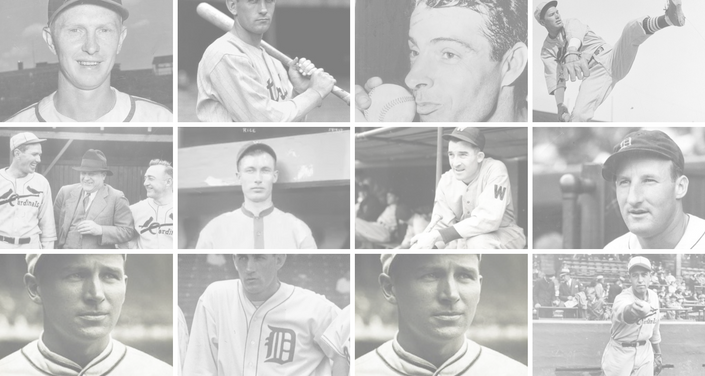Ebbets Field
Ebbets Field was on the block bound by Bedford Avenue, Sullivan Place, McKeever Place, and Montgomery Street. After locating the prospective new site to build a permanent stadium to replace the old (and wooden) Washington Park, club owner Charlie Ebbets acquired the property over several years, starting in 1908, by buying parcels of land until he owned the entire block. This land included the site of a garbage dump called Pigtown because of the pigs that once ate their fill there and the stench that filled the air. In 1912, construction began. By the time it was completed, a year later, Pigtown had been transformed into Ebbets Field – baseball’s newest shrine, where some of the game’s greatest drama would take place.
Following an inter-league exhibition game against the New York Yankees on April 5, 1913, the park formally opened on April 9 against the Philadelphia Phillies. Initially the seating area was a double deck from past third base, around home plate, and all the way down the right side. There was an open, concrete bleacher extending the rest of the way down the left side to the outer wall. There was no seating in left or center. The right field wall was fairly high due to the short foul line (around 300 feet) but had no screen or scoreboard at first. The ballpark was built on a sloping piece of ground. The right field wall made up the difference, as the right field corner was above street level. The left field corner was below street level, and there was an incline or “terrace” running along the left field wall.
As was the case of Boston’s Fenway Park and Detroit’s Tiger Stadium (two ballparks that opened one year earlier, in 1912), the intimate configuration prompted some baseball writers to refer to Ebbets Field as a “cigar box” or a “bandbox.”
Ebbets Field was the scene of some early successes, as the “Robins” (so-called for long-time manager Wilbert Robinson) won league championships in 1916 and 1920. The Ebbets seating area was expanded in the 1920s, a “boom” time for baseball when many ballparks were expanded. The double deck was extended from third base around the left field corner, across left field, and into center field, covering the terrace and allowing right-hand hitters to garner many more home runs. By the 1940s, the big scoreboard had been installed, as well as a screen atop the high wall, which made right field home runs a little harder to come by. However, additional rows of seating across left field reduced that area by about 15 feet, to the delight of the sluggers.
After the early successes, though, the team slid into some hard times, which would continue for a couple of decades, until new ownership brought in first promotional wizard Larry MacPhail (in 1938), then, after MacPhail’s wartime resignation, player development genius Branch Rickey (in 1943). In addition to his well-known breaking of the color line by signing Jackie Robinson, Rickey’s savvy with farm systems (as with his prior work for the St. Louis Cardinals) produced results that made the Brooklyn Dodgers “Bums” a perennial contender, which they would continue to be for decades to come.
The Dodgers won pennants in 1941 (under MacPhail), 1947, 1949, 1952, 1953, 1955 and 1956. They won the 1955 World Series (the only world title in Brooklyn Dodgers history), and were within two games and a playoff heartbreak of winning five NL pennants in a row (1949–53) and matching the cross-town Yankees’ achievement during that stretch. Ebbets also hosted the 1949 Major League Baseball All-Star Game.
The Dodgers were soon victims of their own success, because only a limited number of eager fans could cram into minuscule Ebbets Field, and it had almost no automobile parking for Dodger fans who had moved east to suburban Long Island, though it was near a subway station. Club owner Walter O’Malley announced plans for a privately-owned domed stadium for his Dodgers at the Atlantic Yards in Brooklyn, where a large market was being torn down, but New York City Building Commissioner Robert Moses wanted the city to build a stadium located in Flushing Meadows in the borough of Queens (the future site of Shea Stadium and Citi Field). O’Malley refused to consider Moses’ position, and Moses refused O’Malley’s. As a result, O’Malley began to flirt publicly with Los Angeles, using a relocation threat as political leverage to win favor with his desired Brooklyn stadium. Ultimately, O’Malley and Moses could never come to agreement on a new location for the Dodgers, and the club moved west to Los Angeles. During the last two years in Brooklyn, the Dodgers played several games each year in Jersey City, New Jersey’s Roosevelt Stadium, as part of O’Malley’s additional tactics to force a new stadium to be built.
The Dodgers moved to Los Angeles, California, after the 1957 season, while their long-time crosstown rivals the New York Giants moved to San Francisco, based upon O’Malley’s urging to Giants owner Horace Stoneham. That meant lights out for Ebbets Field, which was demolished, beginning on February 23, 1960. O’Malley’s removal of the franchise from its historic home has been referred to as “one of the most infamous abandonments in the history of sport” by the New York Courts. California courts, if ever called upon to express an opinion, doubtless would have a different view.
Legacy
Ebbets Field was but one of several historic major league ballparks demolished in the 1960s, but more mythology and nostalgia surrounds the stadium and its demise than possibly any other defunct ballpark.
A great deal of history happened at Ebbets Field during its relatively short 45-year lifespan with the Dodgers. Of the many teams that uprooted in the 1950s and 60s, the Dodgers have probably had the largest number of public laments over their fans’ heartbreak over losing their team. A couple of decades later, Roger Kahn’s book The Boys of Summer and Frank Sinatra’s song “There Used to Be a Ballpark” mourned the loss of places like Ebbets Field, and of the attendant youthful innocence of fans and players alike. The story of Ebbets Field and the Brooklyn Dodgers’ move to Los Angeles were also chronicled by historian Doris Kearns Goodwin, figured into the plot of the film Field of Dreams, and were featured in an entire episode of Ken Burns’ public-television documentary Baseball, as well as a 2007 HBO documentary called Brooklyn Dodgers: Ghosts of Flatbush.
Ebbets Field is arguably a more popular venue now than when it actually stood. Some fans who did attend games at the stadium remember it as cramped and decrepit towards the end of its life. The famous rotunda was said to be a bottleneck in the concourse. Baseball historians occasionally point out that although the stadium was no doubt a pleasant place to watch a ballgame, architecturally speaking it was not any more remarkable than several other “lost parks.” As of 2010, the Dodgers have played in Dodger Stadium for more years (49 through the 2010 season) than they played in Ebbets Field (45). Shea Stadium’s duration (1964–2008) was the same as Ebbets Field’s.
However, Ebbets Field has managed to transcend the realm of mere fact to become a kind of icon for what many see as the golden era of the national pastime, and its destruction symbolic of the “lost innocence” of a bygone era. Its influence can be seen in the current ballpark of the New York Mets, Citi Field, which features replicas of Ebbets’ exterior façade and entry rotunda, which is named in honor of Jackie Robinson.
Subsequent use of the former Ebbets Field site
Apartments were built upon the former Ebbets Field site, and were named the Ebbets Field Apartments upon their opening in 1962 and were later renamed the Jackie Robinson Apartments in 1972, the same year Robinson died. MS 320, a school across McKeever Place, has been renamed Jackie Robinson Intermediate School.
Other sports at Ebbets Field
Though known as a cathedral for baseball, other sports were played at Ebbets Field as well. In addition to the professional football teams that played at the stadium, it was also home to Manhattan College’s football team from 1932-1937.
The stadium also hosted a number of soccer games. On April 11, 1926, Ebbets Field hosted the US National Challenge Cup soccer tournament (now known as the Lamar Hunt U.S. Open Cup). Bethlehem Steel F.C. from Pennsylvania of the American Soccer League won its sixth and final National Challenge Cup title, scoring a convincing 7-2 victory over Ben Miller F.C. of St. Louis in the final before more than 18, 000 fans. On June 7, 1931, over 10,000 fans came out to Ebbets Field to watch Celtic of Scotland crush local side Brooklyn Wanderers 5 – 0. On June 17, 1947, the first known televised soccer game in the US took place at Ebbets Field when Hapoel Tel Aviv lost to the American League Stars 2 – 0. On June 18, 1948, Liverpool of England beat Djurgården of Sweden 3 – 2 in front of 20,000 fans at Ebbets Field. On October 17 of that year, the U.S. national team beat the Israel national team team in front of 25,000 at Ebbets Field. On May 8, 1955, Sunderland of England beat the American league Stars 7 – 2. On May 17, Sunderland tied FC Nürnberg of Germany also at Ebbets. On May 23, 1958, Manchester City of England lost to Hearts of Scotland 5 – 2 in front of 20,000 patrons at Ebbets Field. On June 28, 1959, Napoli of Italy lost to Rapid Vienna of Austria 1 – 0 in front of 18,512. At the rematch, also at Ebbets Field in front of 13,000 people on July 1, Napoli tied Rapid Vienna 1 – 1.
Dimensions
Original (estimates)
• Left field pole – 419 ft
• Center field deep – 477 ft
• Right field pole – 301 ft
1932-1947
• Left field pole – 348 ft (unposted)
• Left field corner – 357 ft
• Left-center field – 365 ft
• Deep left-center – 407 ft
• Deep right-center bleacher corner – 389 ft (unposted)
• Deep right-center notch – 395 ft
• Right-center, scoreboard edges – 344 ft and 318 ft
• Right field pole – 297 ft
1948-1957
• Left field pole – 348 ft
• Left-center field – 351 ft
• Deep left-center – 393 ft
• Deep right-center bleacher corner – 376 ft
• Deep right-center notch – 395 ft
• Right-center, scoreboard edges – 344 ft and 318 ft
• Right field pole – 297 ft
• Backstop – 71 ft
References in literature
In Arthur Miller’s Death of a Salesman, Ebbets Field is mentioned by Willy’s wife, Linda, as the place of Biff’s game (89 in Penguin Plays ed., 1949). This is immediately mocked by their neighbor, Charley, thereby serving as a symbol of the family’s downfall at the hands of modernity and self-delusion. The field is also mentioned in The Zodiacs by Jay Neugeboren, a story about a team in Brooklyn.
The only time I ever saw him excited—-outside of what happened with him and our team—-was when our fathers would take the two of us to games at Ebbets Field.
In The Amazing Adventures of Kavalier and Clay, by Michael Chabon, the novel’s two protagonists attend a Brooklyn Dodgers football game at Ebbets Field.
References in movies
In the movie Heist, Gene Hackman remarks that with enough preparation, one could steal Ebbets Field. Danny DeVito notes that this is impossible since the field has been gone for years. Hackman believes this proves his point.
In 1988’s Field of Dreams, author Terrence Mann (James Earl Jones) was quoted in an interview discovered by Ray Kinsella (Kevin Costner) saying that his childhood dream was to have played baseball with the Brooklyn Dodgers at Ebbets Field, but the team moved to Los Angeles and the field was torn down, and his dream never did come true.
References on television
On the television series, McHale’s Navy, Torpedoman Lester Gruber (Carl Ballantine) often makes mention of his life growing up in Brooklyn. He talks about Bensonhurst and, especially about the Dodgers and Ebbets Field. In an episode entitled, “The Day the War Stood Still”, he even says, “Forward all my mail to Ebbets Field.” In an episode entitled, “Reunion for PT-73”, Mc Hale (Ernest Borgnine) and the crew are trying to convince Captain Binghampton (Joe Flynn) that he is in New York City in 1950. Gruber holds up a newspaper and exclaims, “Those Brooklyn Bums blew another one…..maybe we’ll win the pennant next year…..in ’51!”
Ebbets Field,,Brooklyn,NY,US
Ball Park First Game
Date – 04/26/1913 (5)
Starting Pitchers – vs. Phillies: 04/09/1913
Final Score 1-0 (PHI)
Attendance – 15,000
Starting Pitchers Nap Rucker (BRO); Tom Seaton (PHI)
First Batter – Dode Paskert (PHI) Result – Singled to LF
First Hits – Dode Paskert (PHI),Singled to LF (1st)
First Run – Otto Knabe (PHI)
First RBI – Mickey Doolan (PHI)
First Homerun – Casey Stengel (BRO) vs. Doc Crandall (NY1) on 04/26/1913 (7th inning)
First Grandslam – Ed Konetchy (PIT) vs. Pat Ragan (BRO) on 08/03/1914 (13th inning)
First Inside Park Homerun – Casey Stengel (BRO) vs. Doc Crandall (NY1) on 04/26/1913 (7th inning)
First No Hitter – Dazzy Vance (BRO) vs. Phillies on 09/13/1925
Ball Park Lasts
Last Game – vs. Pirates: 09/24/1957, Final Score – 2-0 (BRO)
Attendance – 6,702
Starting Pitchers – Danny McDevitt (BRO); Bennie Daniels (PIT), Winning Pitcher – Danny McDevitt (BRO) Losing Pitcher – Bennie Daniels (PIT)
Last Batter – Dee Fondy (PIT), result – Grounded to SS
Last Hit – Don Zimmer (BRO), Singled to CF (7)
Last Run – Gino Cimoli (BRO), Last RBI – Gil Hodges (BRO)
Last HR – Duke Snider (BRO) vs. Robin Roberts (PHI) on 09/22/1957 (7th inning)
Last Grand Slam – Gil Hodges (BRO) vs. Vinegar Bend Mizell (SLN) on 07/18/1957 (9th inning)
Last Inside The Park Homerun – Dale Long (CHN) vs. Sandy Koufax (BRO) on 08/28/1957 (4th inning)
Last No Hitter – Sal Maglie (BRO) vs. Phillies on 09/25/1956
TRIVIA –
Duke Snider hit the last two homers at Ebbetts Field in the fifth and seventh innings off Robin Roberts on September 22, 1957.
Notable Events and Chronology for Ebbets Field Career
1926 – The Braves are at Ebbets Field with Brooklyn’s Hank DeBerry on third base, Dazzy Vance on second, and Chick Fewster on first. Babe Herman drives the ball against the right field wall, and DeBerry scores. Vance holds up, then rounds third headed for home. Fewster stops at third base. The RF throws home and traps Vance, who heads back to third. Herman slides into the base as Fewster steps off. Herman is out for passing a baserunner. Fewster, thinking he’s out, too, walks off with Babe, and gets tagged out. Vance, still on third base, later admits it was his fault, but Herman, who doubles into a double play, gets the blame.
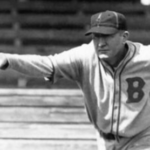
At Ebbets Field, the Robins come from behind to edge the Giants, 3 – 2, behind Dazzy Vance. Harvey Hendrick dinks a 2-run homer in the 8th, off Larry Benton, to tie, and Jake Flowers singles with two out in the 9th to drive home the winner. The ecstatic fans respond by covering the field with straw hats.
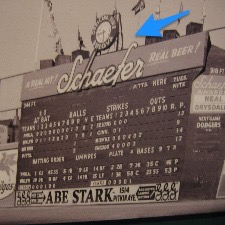
At Brooklyn’s Ebbets Field, Ival Goodman hits an unusual home run when his fifth-inning fly ball lands and stays on top of the scoreboard in right field. With the perched ball considered in play, the three Dodger outfielders watch the Reds’ right fielder round the bases for an easy inside-the park round-tripper in their 7-2 loss to Cincinnati.
Dodger right-hander Fred Frankhouse holds the Reds hitless for 7.2 innings before a heavy downpour ends the Ebbets Field contest permanently. The right-hander’s 5-0 victory will be one of the 31 “no-no’s” erased when MLB redefines a no-hitter in 1991 as a game in which a pitcher throws nine innings or more without giving up a hit.

The five-year ban on broadcasting games played by the New York major league teams ends when Red Barber, hired away from the Reds by Larry McPhail, calls Brooklyn’s 7-3 loss to the Giants at Ebbets Field. In 1934, the two National League teams and the Yankees agreed not to air their games on the radio, fearing the exposure would reduce the number of fans attending games.
Dodger shortstop Tommy Brown becomes the youngest player (17 years, 8 months, and 14 days) in major league history to hit a home run. The round-tripper by ‘Buckshot’, who started his career as a 16 year-old high school student, will be the only run Brooklyn scores off 30 year-old Pirates southpaw Preacher Roe, who goes the distance in the 11-1 rout of the home team at Ebbets Field.

Ernie Harwell, filling in for Red Barber, who is recovering from a bleeding ulcer, calls his first major league game as the Dodgers beat the Cubs at Ebbets Field, 5-4. To obtain the future Hall of Fame broadcaster, Brooklyn general manager Branch Rickey trades minor league catcher Cliff Daper to the Atlanta Crackers.
At Ebbets Field‚ the Braves top the Dodgers‚ 5 – 3‚ in a game that Brooklyn protests. In the 8th inning‚ Duke Snider belts a drive off the CF screen that umpire Artie Gore signals a home run. The Braves point out that‚ according to the ground rules‚ the ball is still in play‚ and Gore sends Snider back to third base. When Duke is stranded there‚ the Dodgers protest. The protest will be rejected by Ford Frick‚ who censors Gore for the confusion he caused by his “bad judgment and slow thinking.”

Every one who shows up with a musical instrument is admitted free to Ebbets Field. 2,426 fans take advantage of the offer, including one with a piano. The Dodgers have a motive in countering the local musicians’ union which wants to silence the non-union Sym-Phoney. The Dodgers outplay the Braves, 7 – 6, as Gil Hodges belts a three-run homer in the 8th, following an intentional walk to Roy Campanella, who had homered earlier.

Mickey Mantle, in the third inning of an eventual 11-7 victory in Game 5, blasts a Russ Meyer pitch high into the upper deck of Ebbets Field, a rare occurrence for a left-handed batter, to become only the fourth player in World Series history to hit a grand slam. The Yankees slugger joins teammate Gil McDougald (1951), Elmer Smith (1920), and Tony Lazzeri (1936) in accomplishing the feat.
In his second start, rookie Brooklyn lefty Karl Spooner shuts out Pittsburgh, 1 – 0, on a Gil Hodges homer in the 8th. He fans 12 for a total of 27 strikeouts in his first two major league games, establishing a new record. Gil Hodges’s 8th-inning homer, his 25th at Ebbets Field (a new club record), gives him 42 for the season, tying him with Duke Snider for the most by a Dodger.
